Free motion machine embroidery is a captivating and versatile form of artistic expression that allows you to create intricate designs and patterns with your sewing machine.
Unlike traditional embroidery, where the fabric is held in an embroidery hoop and the needle follows a predetermined path, free-motion embroidery gives you the freedom to move the fabric in any direction while sewing.
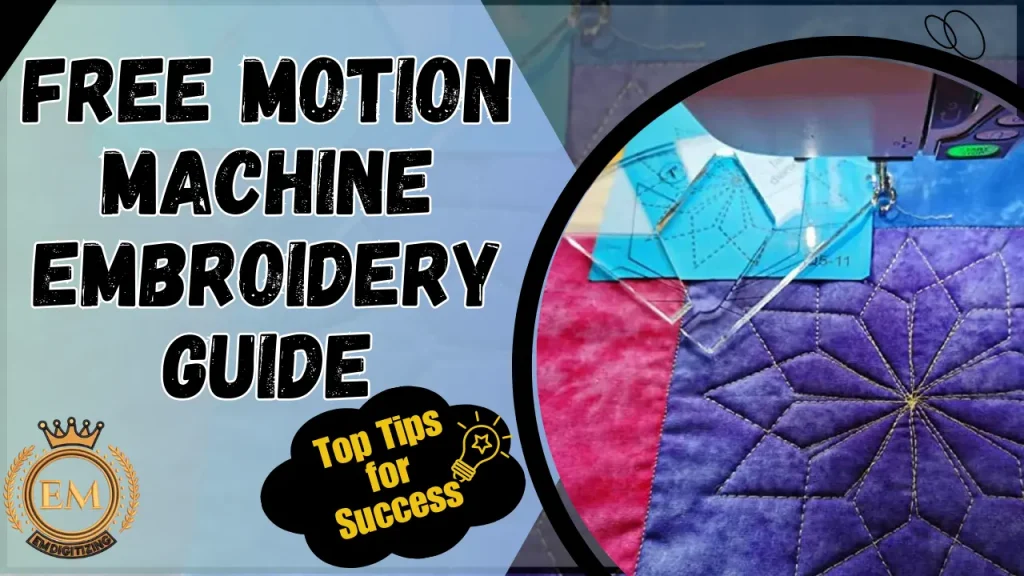
This technique opens up a world of creative possibilities, enabling you to stitch complex motifs, textures, and even realistic images. This article will provide you with essential tips and guidance to master the art of free-motion stitching.
Free Motion Machine Embroidery Guide: Top Tips For Success
What is Free Motion Machine Embroidery?
This stitch type is like drawing with your sewing machine.
Instead of following a predetermined pattern, you have complete control over your stitches and can create unique machine embroidery designs and artwork. It’s like giving your sewing machine a little extra freedom to express itself.
What is Free Motion Machine Embroidery?
There are several benefits to exploring the world of free-motion embroidery.
- First and foremost, it offers endless possibilities for artistic expression and creativity.
- You can create intricate designs, add texture, and experiment with various stitches to give your projects a truly one-of-a-kind look.
- Additionally, free-motion embroidery is a great way to use up fabric scraps, as it doesn’t require large pieces of fabric.
Choosing the Right Materials and Equipment
First thing first, you need to gather all the necessary tools for this embroidery:
Selecting the Appropriate Fabrics for Free Motion Embroidery
When it comes to fabric selection for free motion embroidery, look for materials that are stable and easy to maneuver.

Cotton, linen, and muslin are popular choices due to their versatility and ability to hold up well under the needle. Avoid stretchy or slippery fabrics, as they can be more challenging to work with.
Essential Tools and Supplies for Free Motion Machine Embroidery
To get started with free motion embroidery, you’ll need a few key tools and supplies. Make sure you have an embroidery foot or darning foot for your sewing machine, as it allows you to move the fabric smoothly.
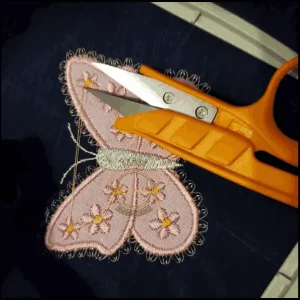
You’ll also need embroidery hoops to hold the fabric tight, embroidery thread in various colors, and a good pair of embroidery scissors for trimming threads.
Setting up Your Sewing Machine for Free Motion Embroidery
Once you find all the necessary materials, start by setting your machine for free motion:
Preparing the Sewing Machine for Free Motion Stitching
Before diving into free-motion embroidery, it’s essential to prepare your Sewing machine properly. Start by removing the regular presser foot and replacing it with the embroidery or darning foot.

Lower the feed dogs or cover them with a free-motion quilting plate, which will allow you to move the fabric freely.
Adjusting Thread Tension for Optimal Results
Achieving the right thread tension is crucial for successful free-motion embroidery. Experiment with different tensions until you find the sweet spot where the top and bobbin threads are balanced.
This will help prevent thread breakage and produce even and smooth stitches.
Choosing the Right Needle and Stitch Length
For free motion embroidery, opt for a sharp or embroidery needle with a size appropriate for your fabric thickness. As a general rule, the larger the needle number, the thicker the fabric it can handle.
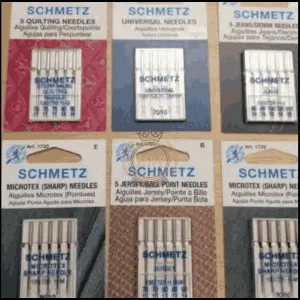
Adjust the stitch length to a low setting, usually around 2mm, to achieve more detailed and controlled stitching.
Mastering Basic Free Motion Techniques
Some basic free-motion techniques can help you in the free-motion embroidery guide:
Understanding the Stippling Technique
Stippling is a popular free-motion technique that involves creating a series of small, random, and closely spaced stitches.
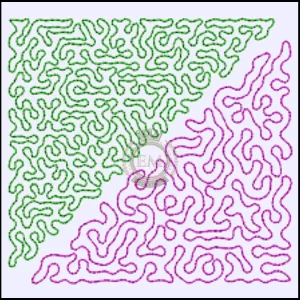
This technique is great for adding texture and filling in large areas. Start by practicing stippling in a square or rectangle shape, gradually moving to more complex designs as you gain confidence.
Creating Smooth and Consistent Lines
To achieve smooth and consistent lines in free-motion embroidery, maintain a steady speed and move the fabric steadily under the needle. Practice drawing straight lines, curves, and swirls to improve your control and precision.
Remember, practice makes perfect!
Adding Texture and Dimension with Fill Stitches
Fill stitches are an excellent way to add texture and dimension to your free-motion embroidery designs. Experiment with different fill stitch patterns, such as cross-hatching, circles, or waves, to see what works best for your project.
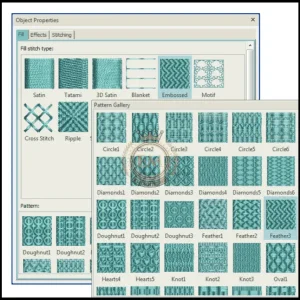
Don’t be afraid to get creative and combine different fill stitches for unique effects!
Advanced Tips and Techniques for Free Motion Machine Embroidery
Advanced tips and techniques can help with free-motion embroidery and are easy to understand:
Exploring Different Stitch Variations
Once you’ve mastered the basics of free-motion embroidery, it’s time to unleash your creativity and explore different stitch variations. From simple straight stitches to intricate loops and swirls, the possibilities are endless.
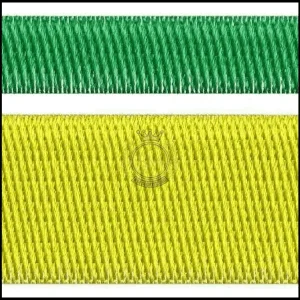
Experiment with different stitch lengths, widths, and patterns to add texture and dimension to your designs. Don’t be afraid to mix and match stitches to create unique and eye-catching effects.
Incorporating Appliqué and Layering Techniques
Take your free-motion embroidery to the next level by incorporating appliqué and layering techniques. Appliqué involves attaching fabric shapes or motifs onto a base fabric, while layering involves adding multiple layers of fabric to create depth and dimension.
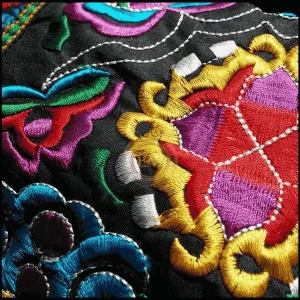
These techniques can bring your designs to life and add an extra level of visual interest. Get creative with different fabrics, textures, and colors to make your embroidery truly stand out.
Working with Metallic and Specialty Threads
If you’re feeling adventurous, why not try working with metallic and specialty threads?
These threads can add a touch of glamour and sparkle to your embroidery. However, they can be a little trickier to work with than regular threads.
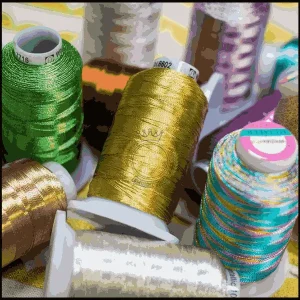
Make sure to adjust your machine’s tension and experiment with different needle sizes to achieve the best results. Remember, patience and practice are key when working with these finicky threads.
Exploring Creative Possibilities with Free Motion Embroidery
You must go through creative possibilities with free motion embroidery:
Designing Your Own Patterns and Motifs
Don’t limit yourself to pre-made patterns and motifs. Embrace your inner artist and design your own! Whether it’s a simple flower or a complex landscape, the ability to create your own designs opens up a world of creative possibilities.
Sketch your ideas on paper and then transfer them onto fabric using a water-soluble pen or transfer paper. This way, you can truly personalize your embroidery and make it a unique reflection of your style and vision.
Combining Free Motion Embroidery with Other Techniques
Free motion embroidery plays well with others!
Don’t be afraid to combine it with other techniques like hand embroidery, appliqué, or even painting. Mixing different artistic mediums can result in stunning and one-of-a-kind creations.
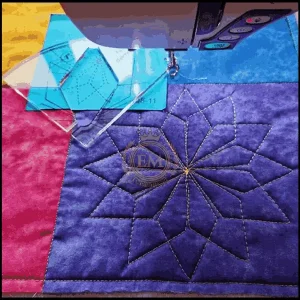
Let your imagination run wild and experiment with various techniques to create harmonious and visually captivating compositions.
Experimenting with Color and Gradient Effects
Color can breathe life into your embroidery, so don’t shy away from experimenting with different color palettes and gradient effects. Playing with shades and hues can add depth and dimension to your designs.
Consider using variegated threads or blending multiple thread colors to achieve stunning color transitions. Remember, there are no strict rules when it comes to color – trust your instincts and let your creativity guide you.
Conclusion
In conclusion, free motion machine embroidery is a versatile and exciting craft that allows you to unleash your creativity and create unique textile art.
With practice, patience, and a willingness to experiment, you can master this technique and take your embroidery skills to new heights.
So gather your supplies, fire up your machine, and let your imagination soar.
Happy stitching!
EMdigitizing: Embroidery Digitizing Expert At Your Service
If you are interested in any kind of embroidery project, then EMdigitizing is the best option for you. We offer embroidery digitizing and vector art services with a fast turnaround time. You can also visit and check our website as well as our best services.
We also offer a great 50% discount on all our services for our respected first-time clients. We also offer free quotes generated in just 5 minutes.
You should grab this limited-time offer and take your embroidery project to the next level with EMdigitizing.
If you’ve any queries regarding this topic, you can ask them. Thank you for taking the time to read this article.
Frequently Asked Questions:
This type of machine allows the user to move the fabric freely under the needle, creating unique and artistic stitch patterns manually. It’s often used for quilting and artistic embroidery.
Free Motion Embroidery Machine: Requires manual control of the fabric to create designs.
Computerized Embroidery Machine: Uses pre-programmed designs and automated functions for precise and repeatable embroidery patterns.
This is subjective and depends on the user’s needs. For beginners, user-friendly models with basic features are ideal. For professionals, advanced computerized machines offer more capabilities. Brands like Brother, Janome, and Bernina are often recommended.
High-end models from luxury brands or machines with advanced features like multi-needle setups, large embroidery fields, and extensive design libraries tend to be the most expensive. Specific models and prices vary.
This is a technique where the sewer controls the fabric manually under the needle to create custom stitches and designs. It allows for greater creativity and is often used in quilting and artistic embroidery.
